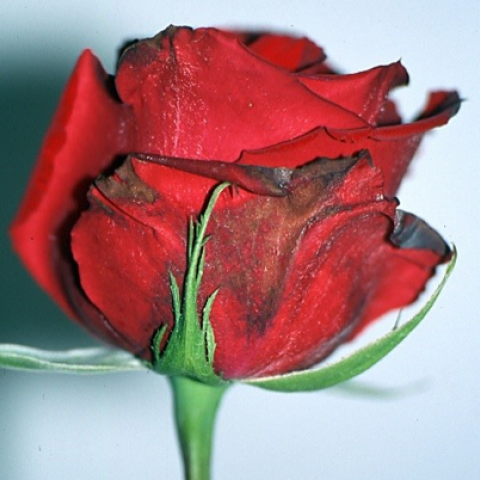The Hidden Enemies of Fresh Flowers: How to Prevent Mold and Bacteria from Shortening Vase Life

Fresh-cut flowers bring beauty and joy to any space, but keeping them looking their best requires more than just water and sunlight. Two invisible enemies—Botrytis (gray mold) and bacterial contamination—can quickly turn vibrant blooms into wilted, dull arrangements.
Understanding how these issues develop and how to prevent them can make all the difference in extending the life and beauty of your flowers.
What Is Botrytis Cinerea?
Also known as gray mold, Botrytis cinerea is a fungal disease that affects many flower varieties, including roses, chrysanthemums, gerberas, and lisianthus. It thrives in cool, damp environments, spreading through tiny airborne spores that settle on petals or leaves.
It often begins as small white or brown spots that expand and cause petals to collapse, leaving behind a fuzzy gray coating. Beyond affecting appearance, Botrytis drastically shortens vase life by destroying delicate flower tissues.
Conditions that favor Botrytis include:
- High humidity or condensation
- Poor air circulation
- Wet petals and leaves
- Contaminated tools or work surfaces
- Dead plant material nearby
The common factor? Moisture. Botrytis spores need humidity to germinate and spread.
How to Protect Flowers from Botrytis
While Botrytis can be difficult to eliminate once present, prevention is entirely possible with good hygiene and environmental control:
1. Improve Air Circulation –
Space plants properly and prune regularly to prevent moisture buildup.
2. Water Smartly –
Water at the base of the plant to keep foliage and petals dry. Morning watering is ideal.
3. Remove Dead Material –
Clear away fallen leaves or petals to reduce fungal food sources.
4. Disinfect Tools and Surfaces –
Clean buckets, knives, and workstations frequently.
5. Control Humidity –
Use dehumidifiers and fans, especially in coolers or greenhouses.
6. Inspect Regularly –
Look for early signs of spots or discoloration on petals.
7. Use Post-Harvest Treatments –
Specialized products like Chrysal Videnti (available in South America) help reduce Botrytis development, improving bloom quality and shelf life.
The Other Threat: Bacterial Contamination in Vase Water
Even the cleanest-looking vase water can quickly become a breeding ground for bacteria. As leaves, petals, and stems decay, they release organic matter that clouds the water and feeds microorganisms.
These bacteria form sticky residues on the vase walls and block the vascular bundles inside flower stems—the channels that carry water. Once blocked, flowers can no longer hydrate properly, resulting in drooping petals and shortened vase life.
How to Prevent Bacterial Contamination
Keeping your flowers fresh starts with simple but consistent care practices:
1. Remove Leaves Below the Waterline –
Submerged foliage decomposes quickly, fueling bacterial growth.
2. Start with a Clean Vase –
Always wash containers with soap or disinfectant before use.
3. Cut Stems at an Angle –
This maximizes water uptake and prevents blockage at the stem base.
4. Re-Cut Stems Every Few Days –
Fresh cuts keep stems open for hydration.
5. Change the Water Regularly –
Replace vase water every 2–3 days, especially in warm rooms.
6. Add Flower Food or Preservative –
Formulas like Chrysal Universal Flower Food nourish blooms while inhibiting bacteria.
The Importance of Water Quality
Not all water is the same. Tap water can vary in pH, mineral content, and quality—all of which affect how well flowers absorb it.
To maintain optimal hydration:
- Use room temperature water.
- Avoid softened water, which can contain salts.
- Use filtered or clean water when possible.
Clean water ensures cells stay firm and vibrant, giving flowers the support they need to stay fresh longer.
Final Thoughts
Whether you’re a grower, florist, or flower enthusiast, keeping flowers beautiful starts with good hygiene and preventative care.
By managing humidity, keeping tools clean, changing water regularly, and using professional floral care solutions, you can significantly reduce the risks of both Botrytis and bacterial contamination.
A little extra care goes a long way—helping your flowers bloom brighter, longer, and healthier.
Prefer a Printable Version?
If you’d like to keep this article handy or share it with your team, click here to download the PDF version.

Dennis Wheeler —North America Sales Manager, Chrysal Americas
With nearly four decades of experience in the horticultural industry, Dennis Wheeler is a trusted expert in post-harvest flower care. As North America Sales Manager for Chrysal Americas, Dennis partners with growers, wholesalers, and retailers to improve flower longevity and quality from farm to vase. His career began in greenhouse production, where he developed a deep understanding of plant health and handling—knowledge that continues to guide his work helping customers achieve fresher, longer-lasting blooms.

